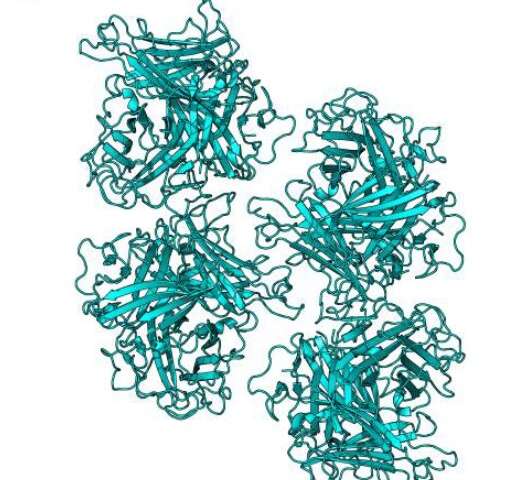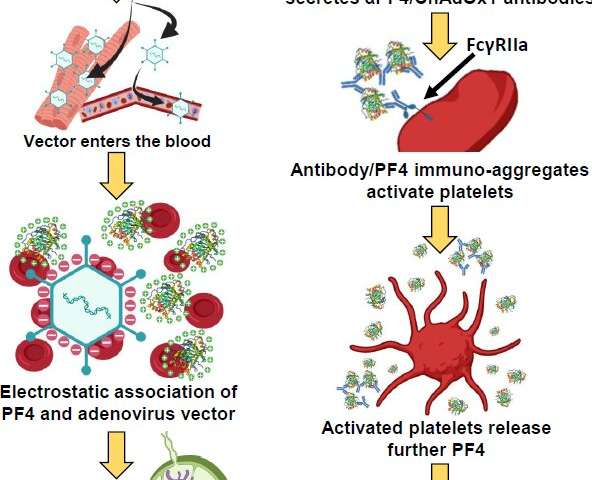Trigger of rare blood clots with AstraZeneca and other COVID vaccines found by scientists

Understanding rare blood clots caused by some COVID vaccines—important first step to prevention
A collaborative team from the School of Medicine at the University of Cardiff, Wales and a range of US institutions used the UK's national synchrotron, Diamond Light Source, to help reveal the details of how a protein in the blood is attracted to a key component of Adenovirus based vaccines.
They think this protein kicks off a chain reaction, involving the immune system, that can culminate in extremely rare but dangerous blood clots. The Cardiff team were given emergency government funding to find the answers. In collaboration with scientists in the US and from AstraZeneca, they set out to collect data on the structure of the vaccines and perform computer simulations and related experiments to try and uncover why some of the vaccines based on Adenovirus were causing blood clots in rare cases.
Moderna and BioNTech are based on mRNA, whereas AstraZeneca and Johnson & Johnson are based on Adenoviruses. Blood clots have only been associated with vaccines that use Adenoviruses.
Understanding the thrombotic effect
The study, published in the journal Science Advances, reveals the outer surface of the adenovirus attracts the platelet factor four (PF4) protein to it like a magnet. Their data confirm that PF4 is capable of forming stable complexes with clinically relevant adenoviruses, an important step in unraveling the mechanisms underlying thrombosis with thrombocytopenia syndrome (TTS).
Prof Alan Parker, one of the researchers at Cardiff University, told BBC News: "The adenovirus has an extremely negative surface, and platelet factor four is extremely positive and the two things fit together quite well." He added: "We've been able to prove the link between the key smoking guns of adenoviruses and platelet factor four. What we have is the trigger, but there's a lot of steps that have to happen next."
Focus on protein structures
Researchers set out to collect data on the structure of the vaccines and perform computer simulations to try and uncover why some of the vaccines were causing blood clots. They began by gathering structural data on the Adenovirus ChAdOx1 which is used in the AstraZeneca vaccine. The team used Cryo-Electron Microscopy (cryo-EM) – which achieves near atomic resolution –to solve the structure of the virus capsid, however they need higher resolution images of the knob proteins that interact with human cells. For this, they performed protein crystallography at the I03 beamline at Diamond. . Using these two complementary techniques, they were able to get accurate and high-resolution structures of the Adenovirus.
Once the structure was known, the research team could then test which human proteins were binding to the virus. They found a receptor that binds strongly to the ChAdOx1 fibre-knob protein. This receptor known as "CAR" is highly conserved between humans and chimpanzees, which makes sense as this virus can infect both species. This finding is important as it is the first verified example of human and primate adenoviruses sharing the same receptor.
Diamond's Macromolecular Crystallography (MX) Group Leader, Dave Hall, commented: "High-resolution experimental structural information is vital to align alongside and inform lab-based and clinical experiments. Coupled with computational analyses, it can draw the link between what is happening at an atomistic level and the cellular level, all the way through to the impact on human health."
The research team performed computer simulations with the ChAdOx1 and the PF4 protein. They found that there were two factors that led to the Adenovirus and PF4 interacting more than was expected by chance. The first was that the Adenovirus had some flexibility and that led to a conformation allowing PF4 to fit snugly with the Adenovirus. The second finding was that the electrostatic charge on the Adenovirus was attracting PF4. These two factors created ideal conditions for interaction, and it was this that could lead to PF4 being recognised as foreign by the human immune system.

How the immune response is triggered
The team used their data and compared it to previously published work. They concurred with previous work that the presence of ChAdOx1 was causing an immune response against PF4. However, the research team suggested a brand-new mechanism by which this occurred. They proposed that small quantities of ChAdOx1 are entering the bloodstream at the injection site. The injection may cause the release of PF4 which then associates with the adenovirus in the blood and causes the immune response.
While extremely rare, the blood clots associated with certain vaccines have caused concern among the public and experts alike. Finding explanations for the clots is the first step to preventing them in the future. The team already noted that not all adenoviruses have the same electrostatic charge, so reducing the number of blood clots could be a matter of choosing a different viral vector for the vaccine.
For more information about Diamond's I03 MX beamline, please contact MX Group Leader, Dave Hall: dave.hall@diamond.ac.uk
Related Publication:
Baker A.T. et al. ChAdOx1 interacts with CAR and PF4 with implications for thrombosis with thrombocytopenia syndrome. Science Advances Vol 7, 49. (Dec 2021). DOI: 10.1126/sciadv.abl8213
For further information please contact Diamond Communications: Lorna Campbell +44 7836 625999 or Isabelle Boscaro-Clarke +44 1235 778130 Diamond Light Source: www.diamond.ac.uk Twitter: @DiamondLightSou
About Diamond Light Source provides industrial and academic user communities with access to state-of-the-art analytical tools to enable world-changing science. Shaped like a huge ring, it works like a giant microscope, accelerating electrons to near light speeds, to produce a light 10 billion times brighter than the Sun, which is then directed off into 33 laboratories known as 'beamlines'. In addition to these, Diamond offers access to several integrated laboratories including the world-class Electron Bio-imaging Centre (eBIC) and the Electron Physical Science Imaging Centre (ePSIC).
Diamond serves as an agent of change, addressing 21st century challenges such as disease, clean energy, food security and more. Since operations started, more than 14,000 researchers from both academia and industry have used Diamond to conduct experiments, with the support of approximately 760 world-class staff. More than 10,000 scientific articles have been published by our users and scientists.
Funded by the UK Government through the Science and Technology Facilities Council (STFC), and by Wellcome, Diamond is one of the most advanced scientific facilities in the world, and its pioneering capabilities are helping to keep the UK at the forefront of scientific research.
More information:
Baker A.T. et al. ChAdOx1 interacts with CAR and PF4 with implications for thrombosis with thrombocytopenia syndrome. Science Advances Vol 7, 49. (Dec 2021). DOI: 10.1126/sciadv.abl8213
Provided by Diamond Light Source